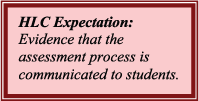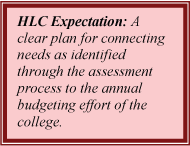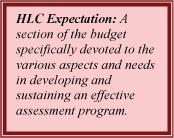

2005-2006 Entering the Maintenance Phase
- Expanding Awareness
The 2005-2006 school year was the end of much of the development
and the implementation of the assessment system, and the start of
the maintenance cycle. More familiar with procedural tasks,
instructors explored in depth the potential for designing
assessment events which were more aligned to their own existent
questions. Instructors were introduced to the new gen ed competency
checklists, and efforts to expand the awareness and understanding
of assessment to all members of the learning college were
undertaken more aggressively.
 A member of the Core Team was charged with
developing materials and strategies for introducing students to
their role in the assessment process. The Core Team tried to
determine what message most faculty had delivered to students as
positive reasons for being involved in assessment. It seemed that
much of the focus was on the benefit to the institution. The Core
Team was eager to shift the emphasis from the institution to that
of the student and the students's own learning. A team of faculty
and counselors met to create a student learning brochure (see
Appendix Q), which framed for students a rationale for
participating in assessment and reflecting upon their own learning.
The brochure indicated ways in which students could discover how
they best learned, and use that information to create strategies
for achieving their identified educational goals. The brochure was
distributed in our orientation course in cooperation with
counselors who helped students map their educational plans. The
brochure was also made available to faculty to deliver and discuss
in their own classes.
A member of the Core Team was charged with
developing materials and strategies for introducing students to
their role in the assessment process. The Core Team tried to
determine what message most faculty had delivered to students as
positive reasons for being involved in assessment. It seemed that
much of the focus was on the benefit to the institution. The Core
Team was eager to shift the emphasis from the institution to that
of the student and the students's own learning. A team of faculty
and counselors met to create a student learning brochure (see
Appendix Q), which framed for students a rationale for
participating in assessment and reflecting upon their own learning.
The brochure indicated ways in which students could discover how
they best learned, and use that information to create strategies
for achieving their identified educational goals. The brochure was
distributed in our orientation course in cooperation with
counselors who helped students map their educational plans. The
brochure was also made available to faculty to deliver and discuss
in their own classes.
In December, 2005, 54 faculty completed an eleven-item survey
based on their knowledge, attitudes, and participation in
assessment and strategic planning. The survey also contained three
open-ended questions about past and future professional development
activities.(See Appendix R for the complete
survey results). The survey offered seven levels of
response along a continuum with contrasting statements at either
end, e.g. I assess because I have to and I assess because it
leads to improved student learning. The items receiving the lowest
scoring levels were those related to understanding the purposes of
assessment and applying data to instructional and institutional
change, e.g. Item 1, quoted above averaged 4.2. The items receiving
the highest scores were those relating to the Area Facilitators and
Core Team and the Learning College, e.g. Item 11, I do not see the
necessity for the Learning College framework and I accept the
embedding of assessment within the Learning College conceptâ€
averaged 6.5.
Faculty appreciated most the workshop days devoted to area and
discipline work and requested more of those activity days. They
also suggested presentation on problem solving and critical
thinking, learning styles, analyzing and applying assessment data,
and more discipline/area-related presentations. A complete copy of
the survey, as well as the full list of comments and answers to
open-ended questions, appears in Appendix R.
This philosophical shift has perhaps been the most significant of changes in our assessment journey. Appendix A Reflection on Transformation is a paper prepared by a senior faculty member, who has observed the college's journey almost from its founding to the present date. It offers wonderful perspective on the certainty of change, while noting that Sauk Valley Community College has always maintained certainty of purpose.
Demonstrating Links among Processes
 Careful consideration went into the
development of the assessment cycle and timeline in light of the
importance of assessment in the budgeting and planning processes of
the College. The cycle exists as part of the strategic planning
master timeline, which coordinates many of the administrative
functions of the College to coincide with deadlines for fiscal
cycles and state-mandated reporting. This alignment guarantees that
appropriately selected, analyzed, and summarized data is available
to decision-making committees at the time it is needed most. The
assessment cycle, then, follows a three-semester model which
maximizes faculty discussion and gives faculty an appropriate
amount of time to research their plans of action to determine if
the plans require additional consideration in terms of budget
allocations or curricular policy changes.
Careful consideration went into the
development of the assessment cycle and timeline in light of the
importance of assessment in the budgeting and planning processes of
the College. The cycle exists as part of the strategic planning
master timeline, which coordinates many of the administrative
functions of the College to coincide with deadlines for fiscal
cycles and state-mandated reporting. This alignment guarantees that
appropriately selected, analyzed, and summarized data is available
to decision-making committees at the time it is needed most. The
assessment cycle, then, follows a three-semester model which
maximizes faculty discussion and gives faculty an appropriate
amount of time to research their plans of action to determine if
the plans require additional consideration in terms of budget
allocations or curricular policy changes.
Data collected in the fall and spring semesters for the year's
transfer and career objectives is reported and aggregated for
discipline-level discussion by August of the next academic year.
Individual instructors will have already analyzed the data and
determined if their personal data collection warrants instructional
or curricular change. Discipline-level conversations will result in
a collective plan of action, which will be implemented based on the
timeline established by the discipline. Area-level aggregation for
transfer programs will be completed in October. General Education
results of the previous year's collection and CAAP testing results
will be digitally aggregated and presented to the full faculty in
late September, in anticipation of the area-level discussions,
where faculty may identify ways in which the area or discipline
could contribute to improving general education scores across the
institution.
Area facilitators then provide the assessment committee with
summaries of area and discipline discussions in November. These
summaries will be analyzed by the assessment committee to determine
which decision-making body is the appropriate receptor of the data.
Plans of action which require financial support will then be
directed to OPIC and considered for the next budget. Plans of
action which require curricular change will be forwarded to the
Curriculum, Policy, and Faculty Development Committee. (A copy of the master timeline
appears in Appendix F.)
Organizational Changes and Resource Allocations in Support of Assessment
Major changes in the organization of the College's decision-making bodies required a significant support network of faculty to oversee the implementation and continuance of the system. To ensure that the process was carried out with faculty as the primary leadership, the Vice President of Learning Services created the Assessment Committee Core Team and allocated funds to allow each member of the team to have release time from one class per semester. Additional money was also released to ensure adequate training opportunities for Core Team members, including materials purchases and conference attendance.
 Another significant organizational change
in support of the new system was the creation of Faculty Discussion
Hours. Each Wednesday from 12:00 to 1:30 pm is set aside as a time
when no classes are offered on campus, providing plenty of
opportunities for the faculty to meet both as a whole and within
programs in order to carry out each level of assessment required to
complete the cycle and feedback loops. Faculty were released from
one office hour per week in order to attend. As a result, there has
been full participation on the part of full-time faculty.
Another significant organizational change
in support of the new system was the creation of Faculty Discussion
Hours. Each Wednesday from 12:00 to 1:30 pm is set aside as a time
when no classes are offered on campus, providing plenty of
opportunities for the faculty to meet both as a whole and within
programs in order to carry out each level of assessment required to
complete the cycle and feedback loops. Faculty were released from
one office hour per week in order to attend. As a result, there has
been full participation on the part of full-time faculty.
The nature of the assessment system, with aggregation, discussion,
and action plans created at both the discipline and program levels,
required that leadership be in place within each program. With that
in mind, the Vice President of Learning Services created the area
facilitator roles—positions for faculty who were willing to become
assessment experts and coordinate the aggregation and reporting for
their areas. The facilitators were granted stipends or release time
from classes and were in charge of calling meetings, maintaining
faculty involvement, keeping records, and reaching out to the
adjunct populations.
Other Budgetary Allocations. Since
the comprehensive visit, the College has channeled significant
financial resources to the improvement of the assessment system and
campus assessment culture. Total expenditures for the program
improvements since the 2002 visit total approximately $188,000,
which was distributed among the following initiatives:
Professional Development. Increasing the faculty's awareness of major assessment topics was addressed in two ways, both by having faculty attend major conferences and by bringing workshop presenters to the College. Faculty attended a broad range of conferences which focused on assessment and related activities, including local conferences such as the Assessment Fair for Community Colleges and national conferences such as the annual HLC conference and the League for Innovation.
- Direct cost for conference attendance was approximately $38,000. Faculty who attended filed reports of findings and gave presentations on the conference materials to the entire faculty at forum sessions.
- Professional development funds were also used to bring speakers to campus, and a grant was used to hire a consultant, Dr. Roberta Teahen. On-campus presenters included Regis McCord, who conducted a session on creating and using rubrics to measure student outcomes, and Smith and Nagel, who conducted a workshop on critical thinking. Total expenditures for workshops and in-service days were approximately $29,000.
Faculty Compensation. The largest part of the
assessment budget, approximately $98,000, has been compensation for
faculty serving as Core Team members and area facilitators. Because
of increasing workloads in the design stages of the plan, those
faculty members were offered release time or stipends equivalent to
overload compensation. It was understood that the design stage of
the process would be the most time-consuming, and that these
incentives would help keep the necessary pace. It is understood
that this level of financial commitment is not possible or
necessary for long-term system management, and that the maintenance
phase will be less time consuming, with much of the workload
subsumed by normal committee duties.
Materials. The final portion of the assessment budget has been dedicated to materials, including CAAP testing supplies, print and publication costs, and memberships in professional organizations. The total cost of these items was approximately $23,000.







